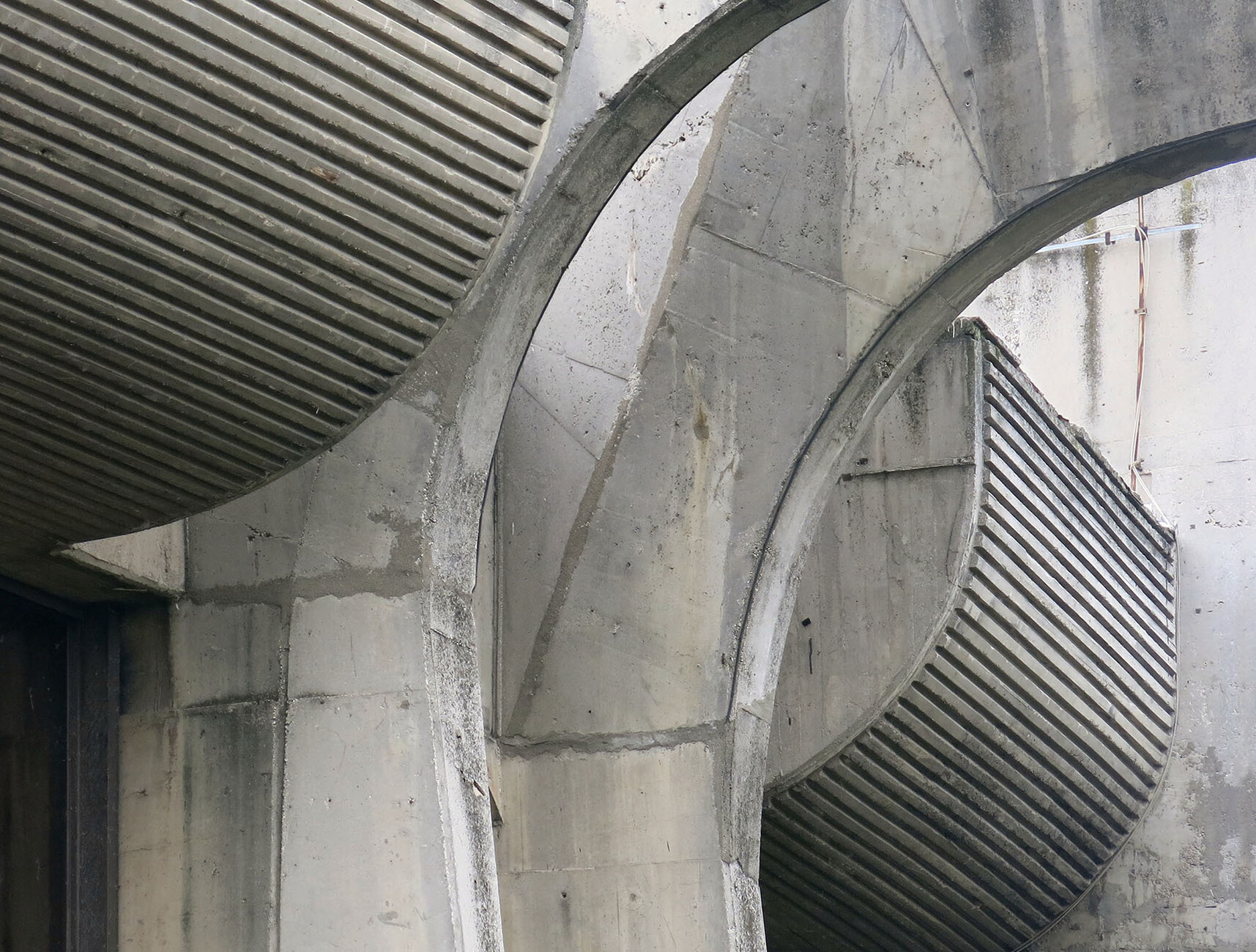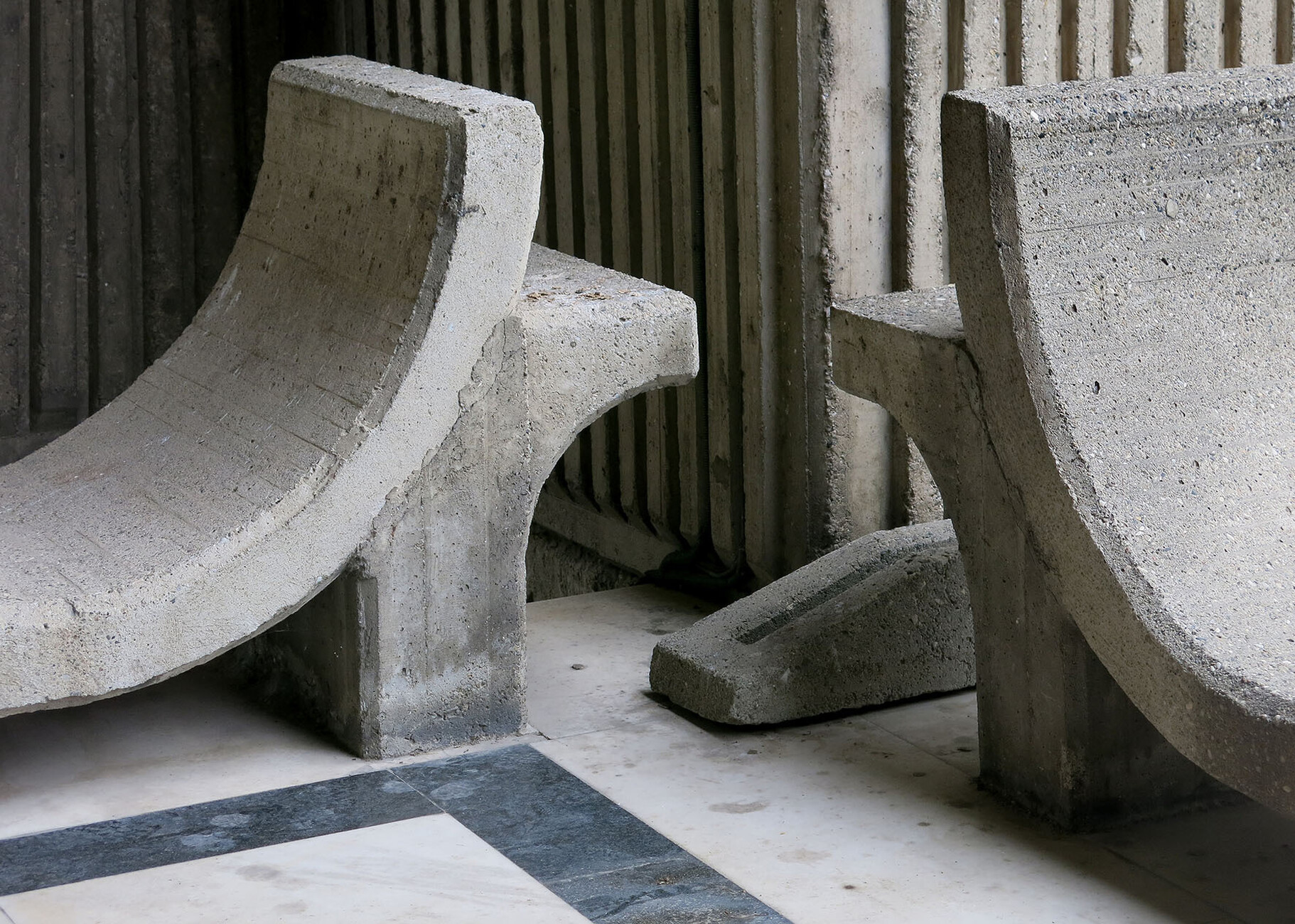Fascinating Tectonics
Bernhard Prinz was born 1953 in Fürth, studied painting at the Academy of Fine Arts in Nuremberg and then began at an early stage to build things, or as he puts it. “I have always concerned myself with spaces, architecture and furnishings as a social reality, created enormous site-specific objects. Then at some point parts of my sculptures found their way into photographs: on large-format portraits with the subjects holding parts of this sculpture in their hands. And suddenly, I was invited to take part in sculpture exhibitions with these photography works,” explains Prinz and adds: “That’s where the twist arises, as people always ask: So what is he? What does he do?” Questions that he evidently finds very productive. We thus setlle on: visual artist. He has never been a sculptor in the classic sense, says Prinz “My objects tended to look more like stage sets or displays, were models in the literal sense both as regards their scale but also in their role as a means of expressing my own experiences and feelings.” In addition to the staged portraits, the allegorical depictions, today he increasingly photographs architectures, memorials and public spaces.
Katharina J. Cichosch: Mr. Prinz, do you see in everything first and foremost a potential topography? When you come across an umbrella, for example, do you then immediately explore its potential for becoming part of a landscape – or is the reverse the case and you look specifically for the individual elements from which you want to create a picture?
Bernhard Prinz: I always have a specific idea in mind, you could say that the image is complete before I put my finger on the shutter release. Then this vision that is often no more than a vague sensation or aura which is difficult to put into words is reproduced in the studio using a wide range of different objects and props. And it is of no consequence whether I already have the items or have to search for them. I consider a work as successful when an arrangement of a good dozen umbrellas and a large number of wildly patterned garments is more reminiscent of the structure of a classic landscape painting rather than being a documentation of what is really spread out on the floor.
You chose to dismiss this notion of photography depicting reality very early on in your career. By contrast, architecture is often seen as something that is inalterably objective – literally perceived as something chiseled in stone"
Bernhard Prinz: A very early work of mine goes by the title Schöne Lüge (Beautiful Lie) (he laughs). The first thing I do is to question the reality that is repersented.
So, someone could quite unabashedly consider your series about architecture to be architectural photographs. But I imagine you would disagree with this view, wouldn’t you?
Bernhard Prinz: Well, those people that primarily take photos of architecture are mainly interested in the style or the history of the buildings, connect them with historical events or social upheavals. But I’m fascinated more by the tectonics of buildings. My curiosity is aroused by the design, construction, materiality and nature. I am not so much concerned with providing a precise documentary rendition but rather recording an atmosphere, a sensation. Given the often-monumental format of my works, the observer is directly confronted with the pictorial space, oscillating between real space and illusory reality.
When you photograph buildings, a bouldering wall for example, or a high-rise housing development, you largely omit the context that locates them. If one didn’t know any better one could also take these architectural structures and surfaces for photographed miniature models. You avoid including any sense of scale.
Bernhard Prinz: Exactly, that is a good example: the bouldering wall. To begin with I still had a piece of the floor in the picture and wondered whether to leave it in or remove it. I decided to take it out. An impression of artificiality and unreality is created by the fact that initially the scale cannot be read exactly. I am interested in the moments when the clarity of what is depicted and consequently the certainty is overturned, when the viewer’s consciousness begins to waver and the readability of the motif fluctuates. Through cropping, perspective or shifts in color my works resist being reliably assigned to a category, they are deprived of their surroundings, of context. However, the works almost always include a detail from which the real proportions can ultimately be inferred, e.g., a light fixture or a fuse box.
This can also be seen in your work “SKOPJE, Fragmente I–X, 2022” (SKOPJE, Fragments I–X, 2022) which appeared last year as an edition. Can you tell us about it?
Bernhard Prinz: I always wanted to do an edition that would act as a footnote or supplement, if you like a more detailed explanation of the familiar bodies of work. While photographing mainly Brutalist architecture and memorials in the Balkans last year I came across what was once the main post office in Skopje, a futuristic-looking building dating from 1982 and featuring various fascinating details. Actually, I wanted to realize a large-format work filling the entire surface but I failed owing to the significant elements of the building. After I had struggled in vain for three days, I decided to make a virtue out of necessity and concentrated on the supposedly disturbing elements and captured striking details in concise sections. Thanks to the cropping and the often-unusual perspective the individual components are strongly abstracted and are more reminiscent of color surface painting or cubist sculptures. This impression is further reinforced by the wear and weathering of the building material.
Does it play a role whether your audience recognizes the buildings in question?
Bernhard Prinz: No, absolutely not! Like in the allegorical portraits that I photograph it is important to me that people first ask themselves: So what is the intention of this person, i.e., the artist? What makes him or her position themselves in this way? And not to immediately jump to the question of what is depicted there and what is the relationship between the artist and the subject? It’s a similar situation with the architectures. The first question the recipient should ask is: How did this happen in the first place, what is the artist trying to achieve? For those people interested in knowing the details there is always a list at my exhibitions that names the buildings, architects and places where the pictures were taken. However, these dates are never part of the work. The fact that for example Oscar Niemeyer realized this building as part of an exhibition site in Lebanon is secondary.
Well, this interview will also be published in English. I wonder how the titles of your works actually translate. How do you handle this when exhibiting abroad? Are additional explanations necessary?
Bernhard Prinz: It’s not that easy, actually. My titles - that are laid out like bait - are often reminiscent of flippantly formulated advertising slogans, maxims from the business world, simple trade names or Christian admonitions. And the sound or the onomatopoeia is often more important than the actual meaning. For example, I used something Malaparte said about his villa on Capri for an early work, namely: triste, dura, severa. You don’t necessarily have to understand Italian; the mere timbre describes the picture. No convincing translation could be found for Zwei Eier im Glas, a diptych with one white and one brown egg that I showed for the first time in the Serpentine Gallery in London. There is no idiom in English that would reflect the work’s pictorial wit. Essentially, when I’m abroad I always use my German titles often set in capital letters and have the local language translation added in small print.
In Kunstforum International Susanne Boecker once wrote: “Bernhard Prinz perceives surfaces without even attempting to look ‘behind the facade’”. She made this comment back then about your portrait works. Can what she said also be applied to your approach to architecture?
Bernhard Prinz: Oh, but that is all really a very long time ago. Back then I also claimed quite provocatively that people I photograph only represent a kind of plasticine from which I then form my intellectual content. As I said before, in my architectural photographs I’m less interested in the history of the buildings or the social changes that always accompany them. Instead, constantly recurring regularities, grids and patterns as well as exposed structural constructions become compressed into the content of my pictures. Often, they are also buildings that are in a kind of intermediate stage, either not yet completed or already given over to decay again, they meander between just being ready and being reduced to ruins.
This meandering works for buildings that are not yet too strongly defined in the visual canon or too burdened by their past history. Are you not still sometimes tempted to cross over this invisible border? And how do you approach your search for motifs – do you know in advance which architectures would make suitable subjects for your work?
Bernhard Prinz: I’ve just spent two and a half weeks in Italy studying rational architecture. There is no denying a certain enthusiasm for this architectural style which was often championed by Mussolini. I come from Nuremberg, practically grew up next to the grounds of the Nazi Party rally or Reichsparteitagsgelände and have always been interested in austere, streamlined building types. Unfortunately, these buildings are usually too well known, too monumental and charged with a portion of political ideology for me to be able to use them for my artistic work. There are a number of earlier works like say Idee – Ideal – Ideologie (Idea – Ideal – Ideology) that explore how we deal with the content of forms and whether you can recycle these formal shells like empty milk bottles. But usually the architectural language is too difficult to separate from the ideological content so that I couldn’t incorporate it into my pictures. No, I would find that too specific.

Edition
Bernhard Prinz
SKOPJE, Fragments I - X, 2022
10 inkjet prints in portfolio
sheet size 40 x 50 cm each
Edition 12 + 3 AP














